Information Systems for Managers: Strategies & Implementation
VerifiedAdded on 2023/06/15
|9
|1941
|382
Report
AI Summary
This report provides an overview of information systems for managers, focusing on enhancing business intelligence through data analytics and effective database management. It explores core business processes and organizational value chains, highlighting the role of enterprise systems in integrating business processes and streamlining activities. The report also discusses strengthening business-to-business relationships via supply chain and customer relationship management, emphasizing the benefits of B2B electronic commerce and CRM in improving customer service and business planning. Furthermore, it examines the system development life cycle (SDLC) and the importance of change management, along with strategies for securing information systems against cyber threats, including computer viruses and denial-of-service attacks. The report concludes by emphasizing the significance of cybersecurity measures and compliance with computer fraud prevention acts.
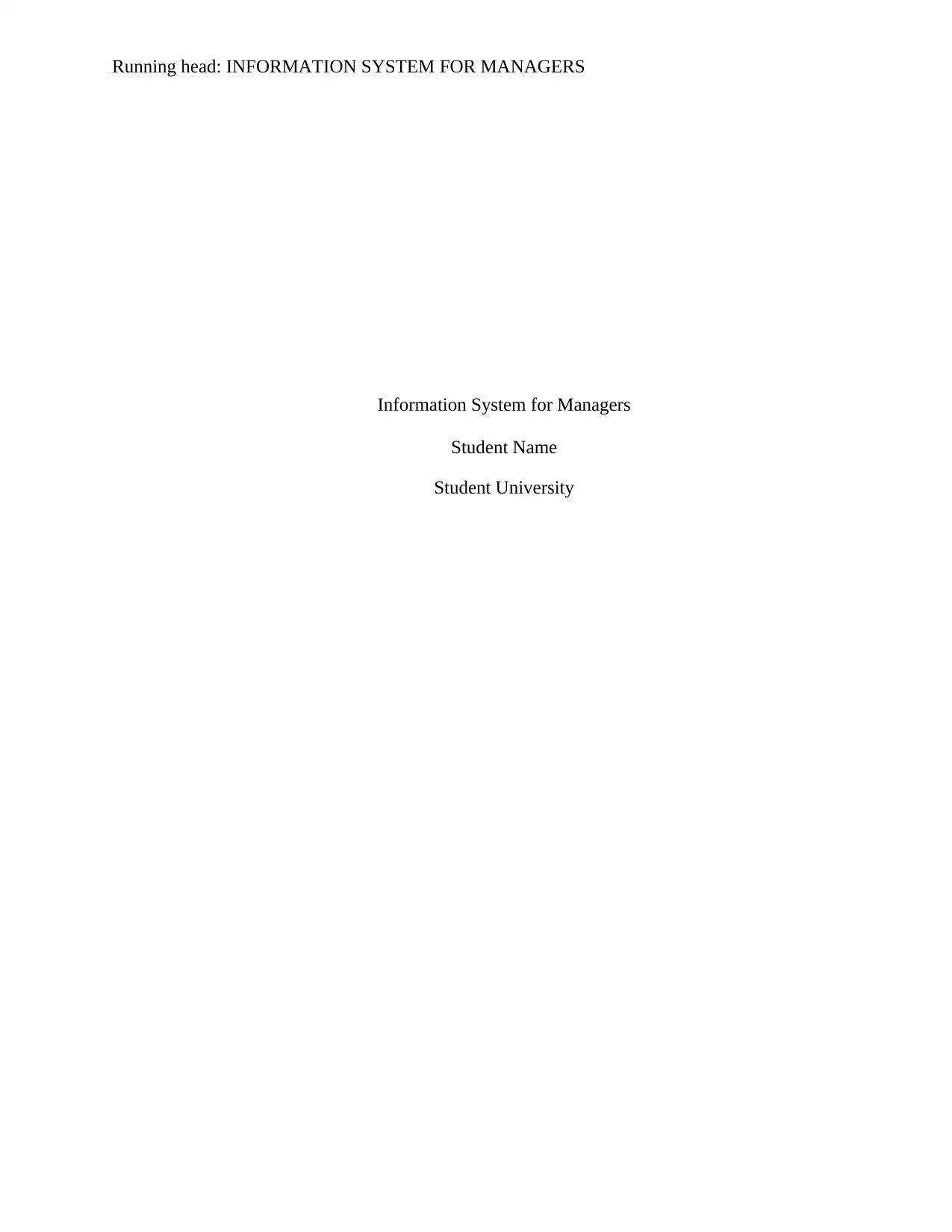
Running head: INFORMATION SYSTEM FOR MANAGERS
Information System for Managers
Student Name
Student University
Information System for Managers
Student Name
Student University
Paraphrase This Document
Need a fresh take? Get an instant paraphrase of this document with our AI Paraphraser
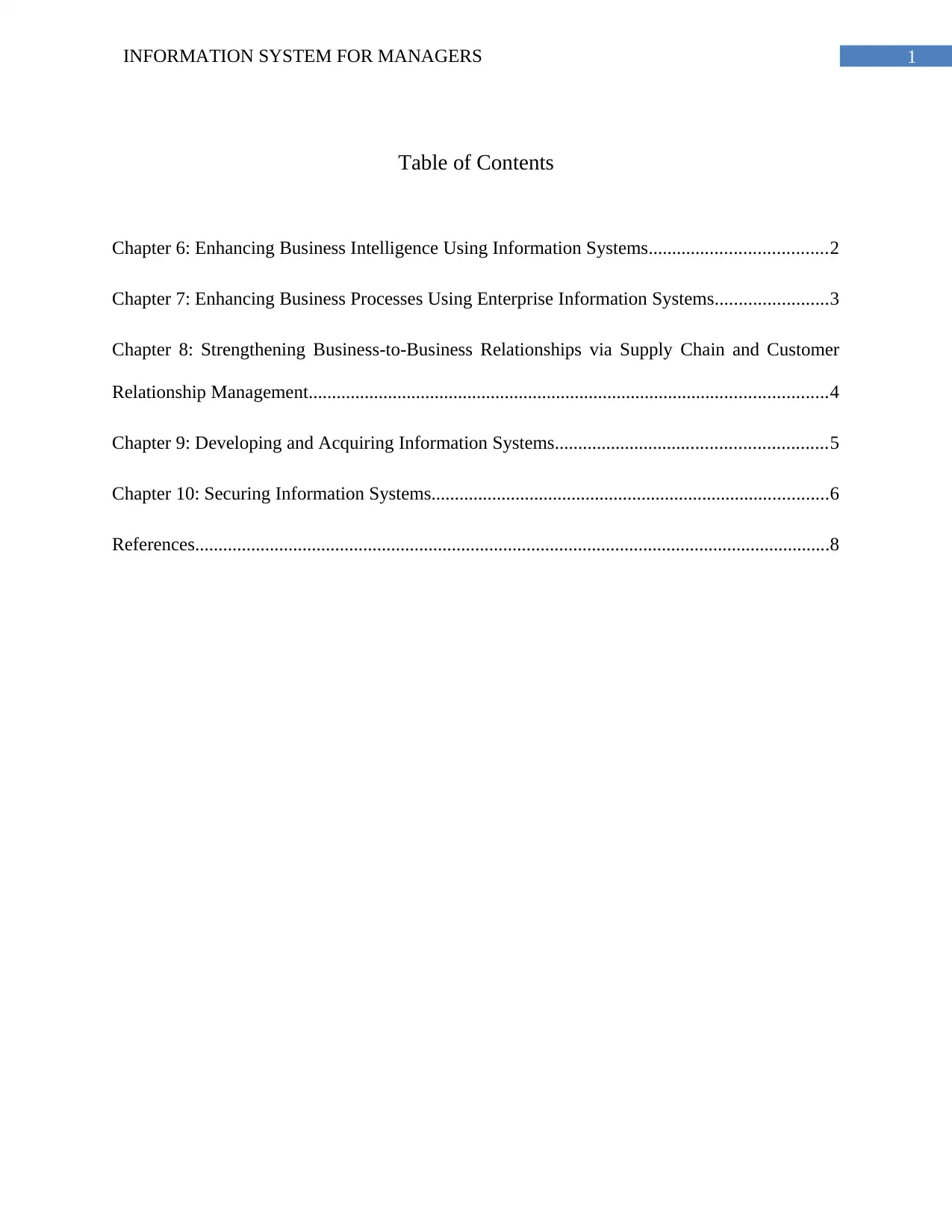
1INFORMATION SYSTEM FOR MANAGERS
Table of Contents
Chapter 6: Enhancing Business Intelligence Using Information Systems......................................2
Chapter 7: Enhancing Business Processes Using Enterprise Information Systems........................3
Chapter 8: Strengthening Business-to-Business Relationships via Supply Chain and Customer
Relationship Management...............................................................................................................4
Chapter 9: Developing and Acquiring Information Systems..........................................................5
Chapter 10: Securing Information Systems.....................................................................................6
References........................................................................................................................................8
Table of Contents
Chapter 6: Enhancing Business Intelligence Using Information Systems......................................2
Chapter 7: Enhancing Business Processes Using Enterprise Information Systems........................3
Chapter 8: Strengthening Business-to-Business Relationships via Supply Chain and Customer
Relationship Management...............................................................................................................4
Chapter 9: Developing and Acquiring Information Systems..........................................................5
Chapter 10: Securing Information Systems.....................................................................................6
References........................................................................................................................................8
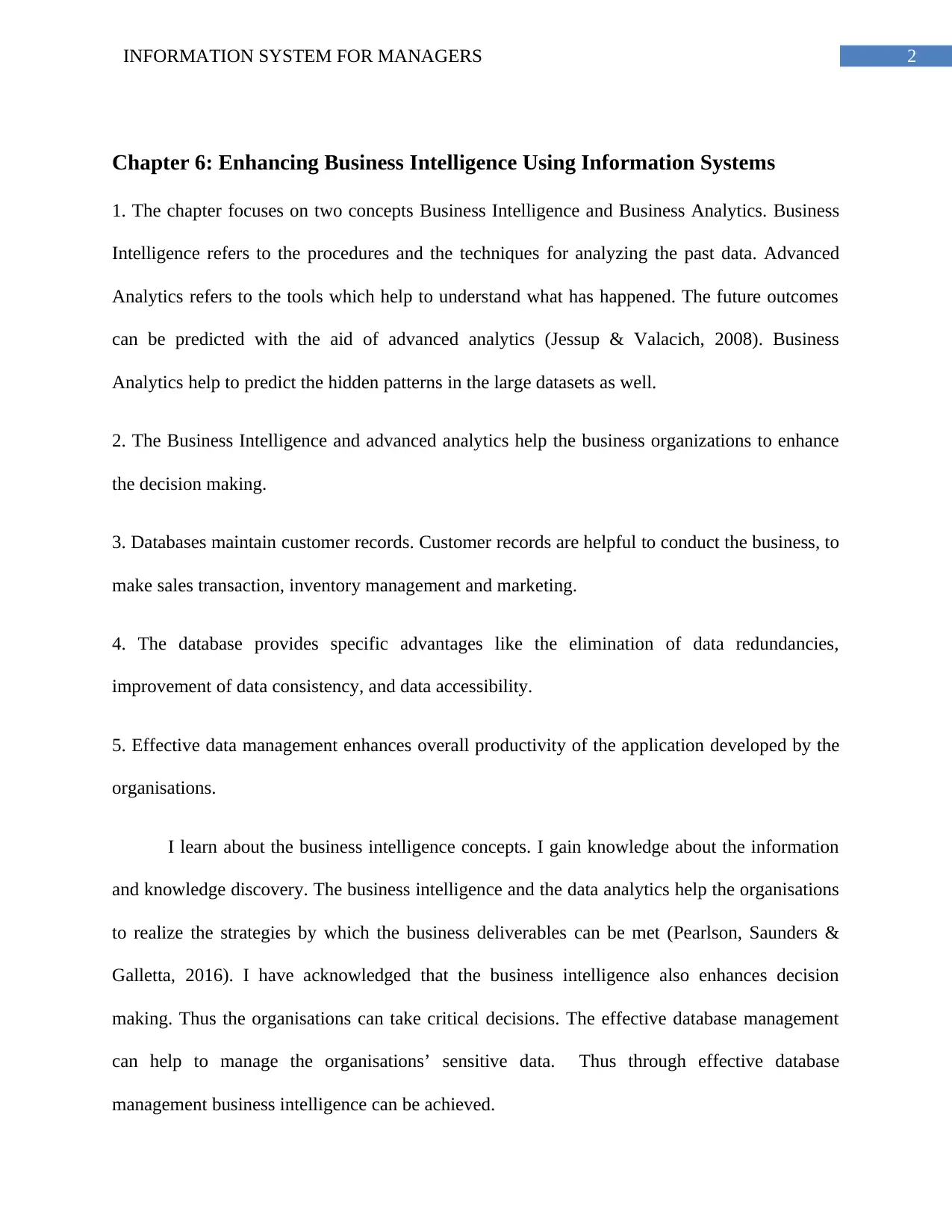
2INFORMATION SYSTEM FOR MANAGERS
Chapter 6: Enhancing Business Intelligence Using Information Systems
1. The chapter focuses on two concepts Business Intelligence and Business Analytics. Business
Intelligence refers to the procedures and the techniques for analyzing the past data. Advanced
Analytics refers to the tools which help to understand what has happened. The future outcomes
can be predicted with the aid of advanced analytics (Jessup & Valacich, 2008). Business
Analytics help to predict the hidden patterns in the large datasets as well.
2. The Business Intelligence and advanced analytics help the business organizations to enhance
the decision making.
3. Databases maintain customer records. Customer records are helpful to conduct the business, to
make sales transaction, inventory management and marketing.
4. The database provides specific advantages like the elimination of data redundancies,
improvement of data consistency, and data accessibility.
5. Effective data management enhances overall productivity of the application developed by the
organisations.
I learn about the business intelligence concepts. I gain knowledge about the information
and knowledge discovery. The business intelligence and the data analytics help the organisations
to realize the strategies by which the business deliverables can be met (Pearlson, Saunders &
Galletta, 2016). I have acknowledged that the business intelligence also enhances decision
making. Thus the organisations can take critical decisions. The effective database management
can help to manage the organisations’ sensitive data. Thus through effective database
management business intelligence can be achieved.
Chapter 6: Enhancing Business Intelligence Using Information Systems
1. The chapter focuses on two concepts Business Intelligence and Business Analytics. Business
Intelligence refers to the procedures and the techniques for analyzing the past data. Advanced
Analytics refers to the tools which help to understand what has happened. The future outcomes
can be predicted with the aid of advanced analytics (Jessup & Valacich, 2008). Business
Analytics help to predict the hidden patterns in the large datasets as well.
2. The Business Intelligence and advanced analytics help the business organizations to enhance
the decision making.
3. Databases maintain customer records. Customer records are helpful to conduct the business, to
make sales transaction, inventory management and marketing.
4. The database provides specific advantages like the elimination of data redundancies,
improvement of data consistency, and data accessibility.
5. Effective data management enhances overall productivity of the application developed by the
organisations.
I learn about the business intelligence concepts. I gain knowledge about the information
and knowledge discovery. The business intelligence and the data analytics help the organisations
to realize the strategies by which the business deliverables can be met (Pearlson, Saunders &
Galletta, 2016). I have acknowledged that the business intelligence also enhances decision
making. Thus the organisations can take critical decisions. The effective database management
can help to manage the organisations’ sensitive data. Thus through effective database
management business intelligence can be achieved.
⊘ This is a preview!⊘
Do you want full access?
Subscribe today to unlock all pages.

Trusted by 1+ million students worldwide
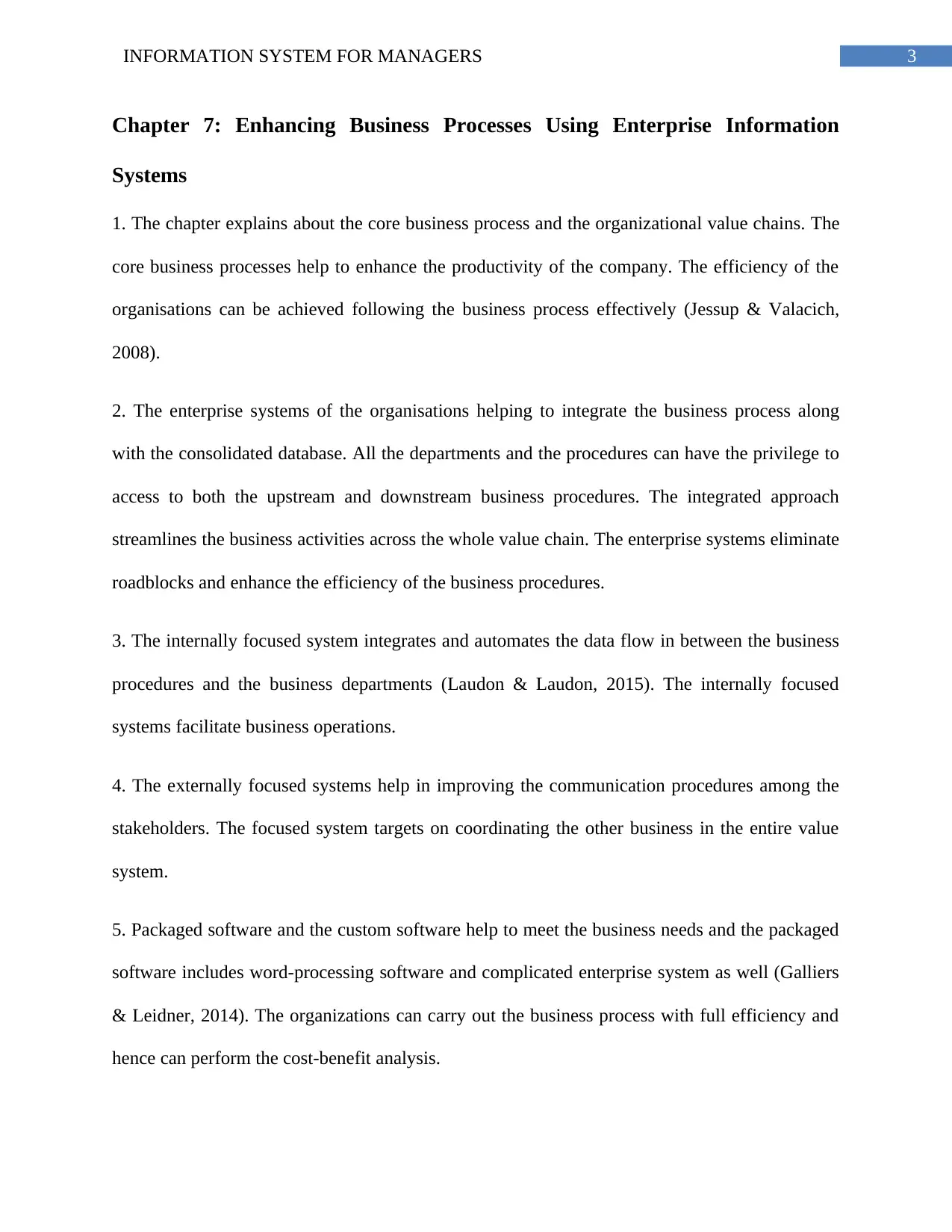
3INFORMATION SYSTEM FOR MANAGERS
Chapter 7: Enhancing Business Processes Using Enterprise Information
Systems
1. The chapter explains about the core business process and the organizational value chains. The
core business processes help to enhance the productivity of the company. The efficiency of the
organisations can be achieved following the business process effectively (Jessup & Valacich,
2008).
2. The enterprise systems of the organisations helping to integrate the business process along
with the consolidated database. All the departments and the procedures can have the privilege to
access to both the upstream and downstream business procedures. The integrated approach
streamlines the business activities across the whole value chain. The enterprise systems eliminate
roadblocks and enhance the efficiency of the business procedures.
3. The internally focused system integrates and automates the data flow in between the business
procedures and the business departments (Laudon & Laudon, 2015). The internally focused
systems facilitate business operations.
4. The externally focused systems help in improving the communication procedures among the
stakeholders. The focused system targets on coordinating the other business in the entire value
system.
5. Packaged software and the custom software help to meet the business needs and the packaged
software includes word-processing software and complicated enterprise system as well (Galliers
& Leidner, 2014). The organizations can carry out the business process with full efficiency and
hence can perform the cost-benefit analysis.
Chapter 7: Enhancing Business Processes Using Enterprise Information
Systems
1. The chapter explains about the core business process and the organizational value chains. The
core business processes help to enhance the productivity of the company. The efficiency of the
organisations can be achieved following the business process effectively (Jessup & Valacich,
2008).
2. The enterprise systems of the organisations helping to integrate the business process along
with the consolidated database. All the departments and the procedures can have the privilege to
access to both the upstream and downstream business procedures. The integrated approach
streamlines the business activities across the whole value chain. The enterprise systems eliminate
roadblocks and enhance the efficiency of the business procedures.
3. The internally focused system integrates and automates the data flow in between the business
procedures and the business departments (Laudon & Laudon, 2015). The internally focused
systems facilitate business operations.
4. The externally focused systems help in improving the communication procedures among the
stakeholders. The focused system targets on coordinating the other business in the entire value
system.
5. Packaged software and the custom software help to meet the business needs and the packaged
software includes word-processing software and complicated enterprise system as well (Galliers
& Leidner, 2014). The organizations can carry out the business process with full efficiency and
hence can perform the cost-benefit analysis.
Paraphrase This Document
Need a fresh take? Get an instant paraphrase of this document with our AI Paraphraser
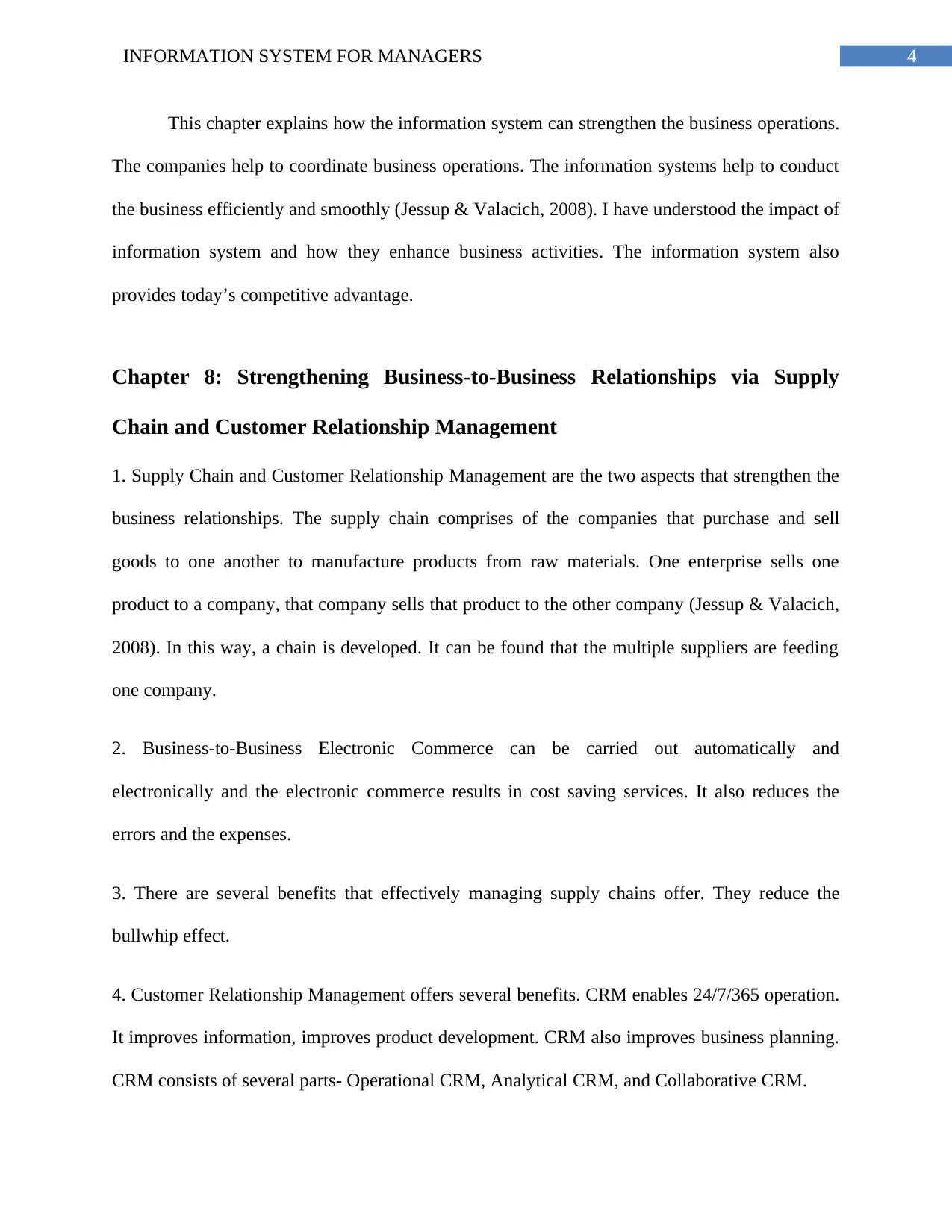
4INFORMATION SYSTEM FOR MANAGERS
This chapter explains how the information system can strengthen the business operations.
The companies help to coordinate business operations. The information systems help to conduct
the business efficiently and smoothly (Jessup & Valacich, 2008). I have understood the impact of
information system and how they enhance business activities. The information system also
provides today’s competitive advantage.
Chapter 8: Strengthening Business-to-Business Relationships via Supply
Chain and Customer Relationship Management
1. Supply Chain and Customer Relationship Management are the two aspects that strengthen the
business relationships. The supply chain comprises of the companies that purchase and sell
goods to one another to manufacture products from raw materials. One enterprise sells one
product to a company, that company sells that product to the other company (Jessup & Valacich,
2008). In this way, a chain is developed. It can be found that the multiple suppliers are feeding
one company.
2. Business-to-Business Electronic Commerce can be carried out automatically and
electronically and the electronic commerce results in cost saving services. It also reduces the
errors and the expenses.
3. There are several benefits that effectively managing supply chains offer. They reduce the
bullwhip effect.
4. Customer Relationship Management offers several benefits. CRM enables 24/7/365 operation.
It improves information, improves product development. CRM also improves business planning.
CRM consists of several parts- Operational CRM, Analytical CRM, and Collaborative CRM.
This chapter explains how the information system can strengthen the business operations.
The companies help to coordinate business operations. The information systems help to conduct
the business efficiently and smoothly (Jessup & Valacich, 2008). I have understood the impact of
information system and how they enhance business activities. The information system also
provides today’s competitive advantage.
Chapter 8: Strengthening Business-to-Business Relationships via Supply
Chain and Customer Relationship Management
1. Supply Chain and Customer Relationship Management are the two aspects that strengthen the
business relationships. The supply chain comprises of the companies that purchase and sell
goods to one another to manufacture products from raw materials. One enterprise sells one
product to a company, that company sells that product to the other company (Jessup & Valacich,
2008). In this way, a chain is developed. It can be found that the multiple suppliers are feeding
one company.
2. Business-to-Business Electronic Commerce can be carried out automatically and
electronically and the electronic commerce results in cost saving services. It also reduces the
errors and the expenses.
3. There are several benefits that effectively managing supply chains offer. They reduce the
bullwhip effect.
4. Customer Relationship Management offers several benefits. CRM enables 24/7/365 operation.
It improves information, improves product development. CRM also improves business planning.
CRM consists of several parts- Operational CRM, Analytical CRM, and Collaborative CRM.
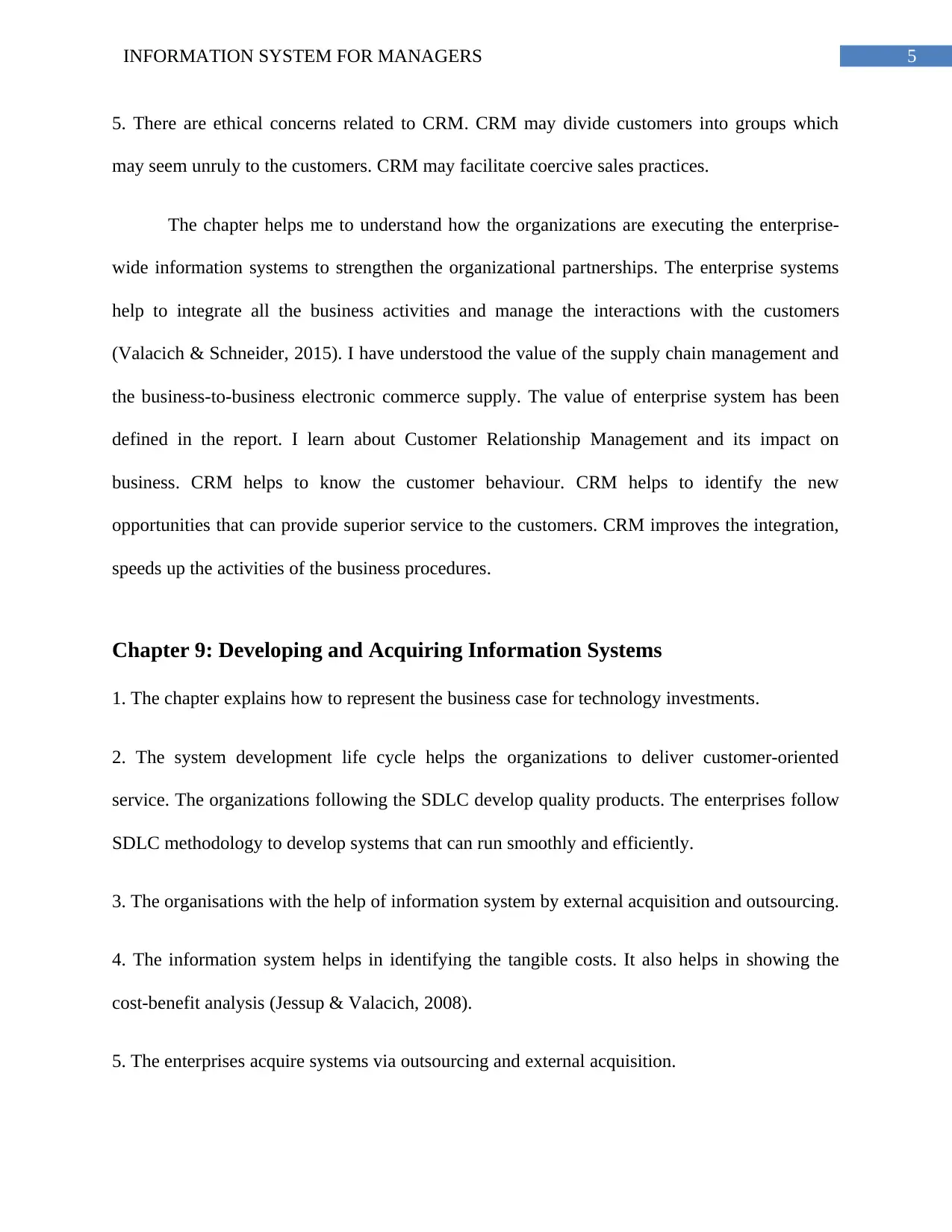
5INFORMATION SYSTEM FOR MANAGERS
5. There are ethical concerns related to CRM. CRM may divide customers into groups which
may seem unruly to the customers. CRM may facilitate coercive sales practices.
The chapter helps me to understand how the organizations are executing the enterprise-
wide information systems to strengthen the organizational partnerships. The enterprise systems
help to integrate all the business activities and manage the interactions with the customers
(Valacich & Schneider, 2015). I have understood the value of the supply chain management and
the business-to-business electronic commerce supply. The value of enterprise system has been
defined in the report. I learn about Customer Relationship Management and its impact on
business. CRM helps to know the customer behaviour. CRM helps to identify the new
opportunities that can provide superior service to the customers. CRM improves the integration,
speeds up the activities of the business procedures.
Chapter 9: Developing and Acquiring Information Systems
1. The chapter explains how to represent the business case for technology investments.
2. The system development life cycle helps the organizations to deliver customer-oriented
service. The organizations following the SDLC develop quality products. The enterprises follow
SDLC methodology to develop systems that can run smoothly and efficiently.
3. The organisations with the help of information system by external acquisition and outsourcing.
4. The information system helps in identifying the tangible costs. It also helps in showing the
cost-benefit analysis (Jessup & Valacich, 2008).
5. The enterprises acquire systems via outsourcing and external acquisition.
5. There are ethical concerns related to CRM. CRM may divide customers into groups which
may seem unruly to the customers. CRM may facilitate coercive sales practices.
The chapter helps me to understand how the organizations are executing the enterprise-
wide information systems to strengthen the organizational partnerships. The enterprise systems
help to integrate all the business activities and manage the interactions with the customers
(Valacich & Schneider, 2015). I have understood the value of the supply chain management and
the business-to-business electronic commerce supply. The value of enterprise system has been
defined in the report. I learn about Customer Relationship Management and its impact on
business. CRM helps to know the customer behaviour. CRM helps to identify the new
opportunities that can provide superior service to the customers. CRM improves the integration,
speeds up the activities of the business procedures.
Chapter 9: Developing and Acquiring Information Systems
1. The chapter explains how to represent the business case for technology investments.
2. The system development life cycle helps the organizations to deliver customer-oriented
service. The organizations following the SDLC develop quality products. The enterprises follow
SDLC methodology to develop systems that can run smoothly and efficiently.
3. The organisations with the help of information system by external acquisition and outsourcing.
4. The information system helps in identifying the tangible costs. It also helps in showing the
cost-benefit analysis (Jessup & Valacich, 2008).
5. The enterprises acquire systems via outsourcing and external acquisition.
⊘ This is a preview!⊘
Do you want full access?
Subscribe today to unlock all pages.

Trusted by 1+ million students worldwide
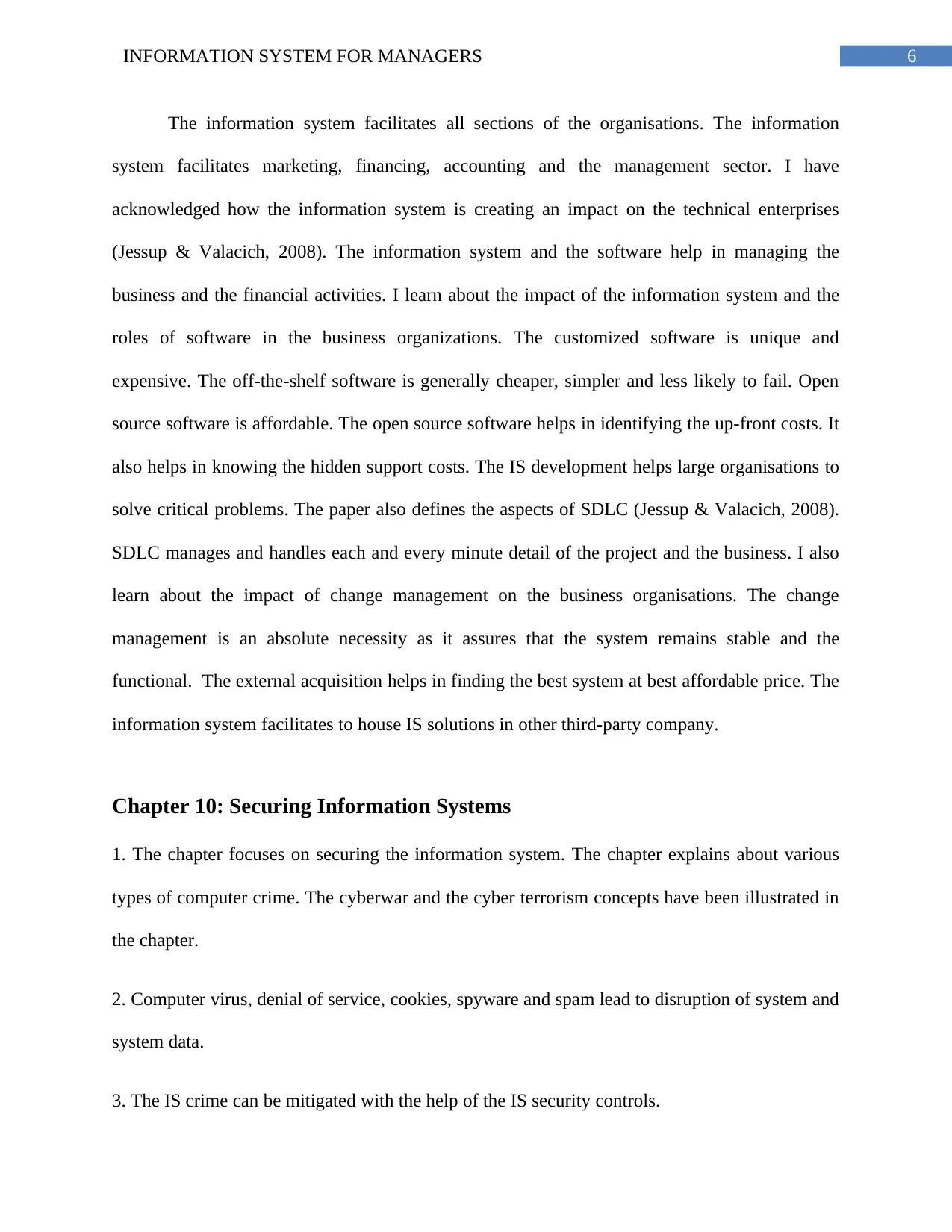
6INFORMATION SYSTEM FOR MANAGERS
The information system facilitates all sections of the organisations. The information
system facilitates marketing, financing, accounting and the management sector. I have
acknowledged how the information system is creating an impact on the technical enterprises
(Jessup & Valacich, 2008). The information system and the software help in managing the
business and the financial activities. I learn about the impact of the information system and the
roles of software in the business organizations. The customized software is unique and
expensive. The off-the-shelf software is generally cheaper, simpler and less likely to fail. Open
source software is affordable. The open source software helps in identifying the up-front costs. It
also helps in knowing the hidden support costs. The IS development helps large organisations to
solve critical problems. The paper also defines the aspects of SDLC (Jessup & Valacich, 2008).
SDLC manages and handles each and every minute detail of the project and the business. I also
learn about the impact of change management on the business organisations. The change
management is an absolute necessity as it assures that the system remains stable and the
functional. The external acquisition helps in finding the best system at best affordable price. The
information system facilitates to house IS solutions in other third-party company.
Chapter 10: Securing Information Systems
1. The chapter focuses on securing the information system. The chapter explains about various
types of computer crime. The cyberwar and the cyber terrorism concepts have been illustrated in
the chapter.
2. Computer virus, denial of service, cookies, spyware and spam lead to disruption of system and
system data.
3. The IS crime can be mitigated with the help of the IS security controls.
The information system facilitates all sections of the organisations. The information
system facilitates marketing, financing, accounting and the management sector. I have
acknowledged how the information system is creating an impact on the technical enterprises
(Jessup & Valacich, 2008). The information system and the software help in managing the
business and the financial activities. I learn about the impact of the information system and the
roles of software in the business organizations. The customized software is unique and
expensive. The off-the-shelf software is generally cheaper, simpler and less likely to fail. Open
source software is affordable. The open source software helps in identifying the up-front costs. It
also helps in knowing the hidden support costs. The IS development helps large organisations to
solve critical problems. The paper also defines the aspects of SDLC (Jessup & Valacich, 2008).
SDLC manages and handles each and every minute detail of the project and the business. I also
learn about the impact of change management on the business organisations. The change
management is an absolute necessity as it assures that the system remains stable and the
functional. The external acquisition helps in finding the best system at best affordable price. The
information system facilitates to house IS solutions in other third-party company.
Chapter 10: Securing Information Systems
1. The chapter focuses on securing the information system. The chapter explains about various
types of computer crime. The cyberwar and the cyber terrorism concepts have been illustrated in
the chapter.
2. Computer virus, denial of service, cookies, spyware and spam lead to disruption of system and
system data.
3. The IS crime can be mitigated with the help of the IS security controls.
Paraphrase This Document
Need a fresh take? Get an instant paraphrase of this document with our AI Paraphraser
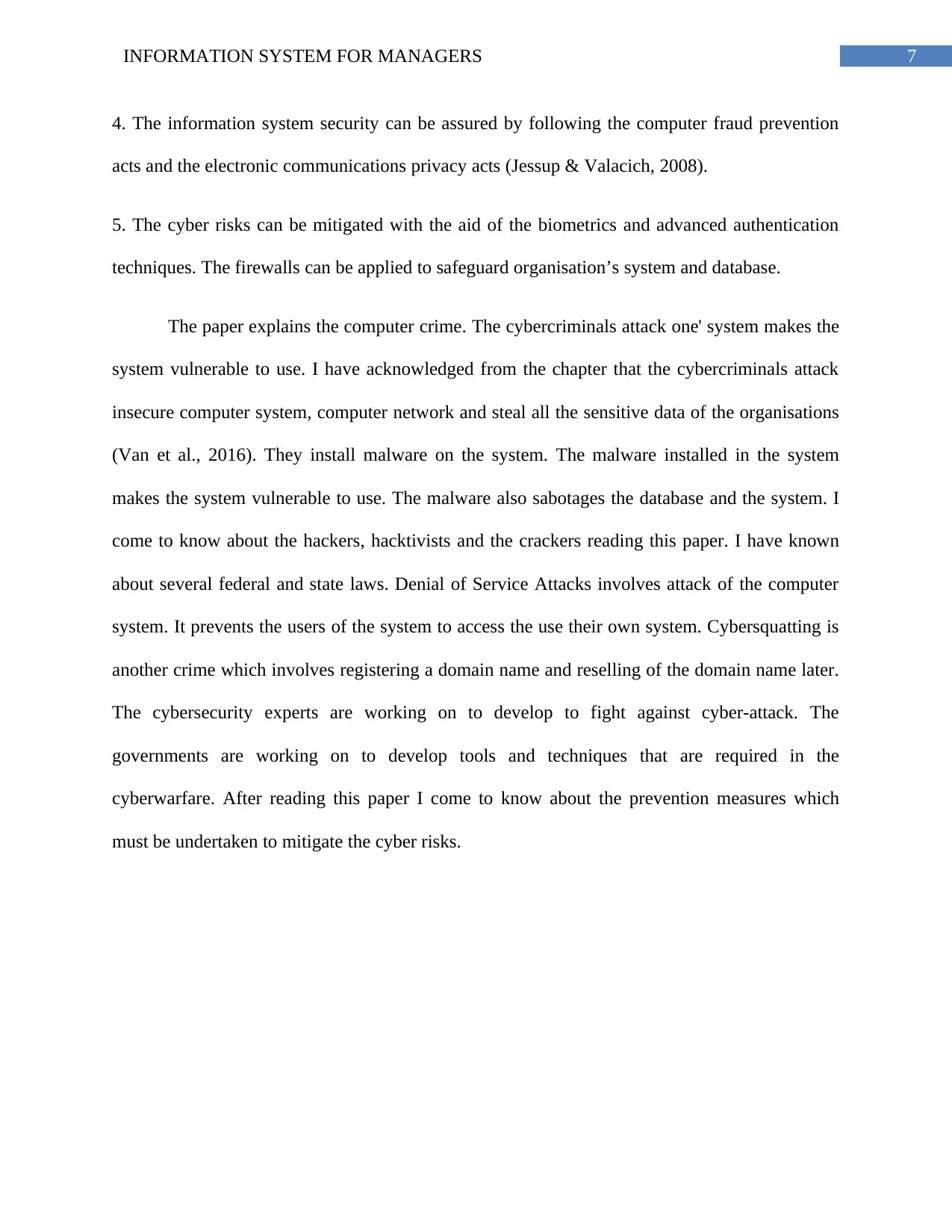
7INFORMATION SYSTEM FOR MANAGERS
4. The information system security can be assured by following the computer fraud prevention
acts and the electronic communications privacy acts (Jessup & Valacich, 2008).
5. The cyber risks can be mitigated with the aid of the biometrics and advanced authentication
techniques. The firewalls can be applied to safeguard organisation’s system and database.
The paper explains the computer crime. The cybercriminals attack one' system makes the
system vulnerable to use. I have acknowledged from the chapter that the cybercriminals attack
insecure computer system, computer network and steal all the sensitive data of the organisations
(Van et al., 2016). They install malware on the system. The malware installed in the system
makes the system vulnerable to use. The malware also sabotages the database and the system. I
come to know about the hackers, hacktivists and the crackers reading this paper. I have known
about several federal and state laws. Denial of Service Attacks involves attack of the computer
system. It prevents the users of the system to access the use their own system. Cybersquatting is
another crime which involves registering a domain name and reselling of the domain name later.
The cybersecurity experts are working on to develop to fight against cyber-attack. The
governments are working on to develop tools and techniques that are required in the
cyberwarfare. After reading this paper I come to know about the prevention measures which
must be undertaken to mitigate the cyber risks.
4. The information system security can be assured by following the computer fraud prevention
acts and the electronic communications privacy acts (Jessup & Valacich, 2008).
5. The cyber risks can be mitigated with the aid of the biometrics and advanced authentication
techniques. The firewalls can be applied to safeguard organisation’s system and database.
The paper explains the computer crime. The cybercriminals attack one' system makes the
system vulnerable to use. I have acknowledged from the chapter that the cybercriminals attack
insecure computer system, computer network and steal all the sensitive data of the organisations
(Van et al., 2016). They install malware on the system. The malware installed in the system
makes the system vulnerable to use. The malware also sabotages the database and the system. I
come to know about the hackers, hacktivists and the crackers reading this paper. I have known
about several federal and state laws. Denial of Service Attacks involves attack of the computer
system. It prevents the users of the system to access the use their own system. Cybersquatting is
another crime which involves registering a domain name and reselling of the domain name later.
The cybersecurity experts are working on to develop to fight against cyber-attack. The
governments are working on to develop tools and techniques that are required in the
cyberwarfare. After reading this paper I come to know about the prevention measures which
must be undertaken to mitigate the cyber risks.
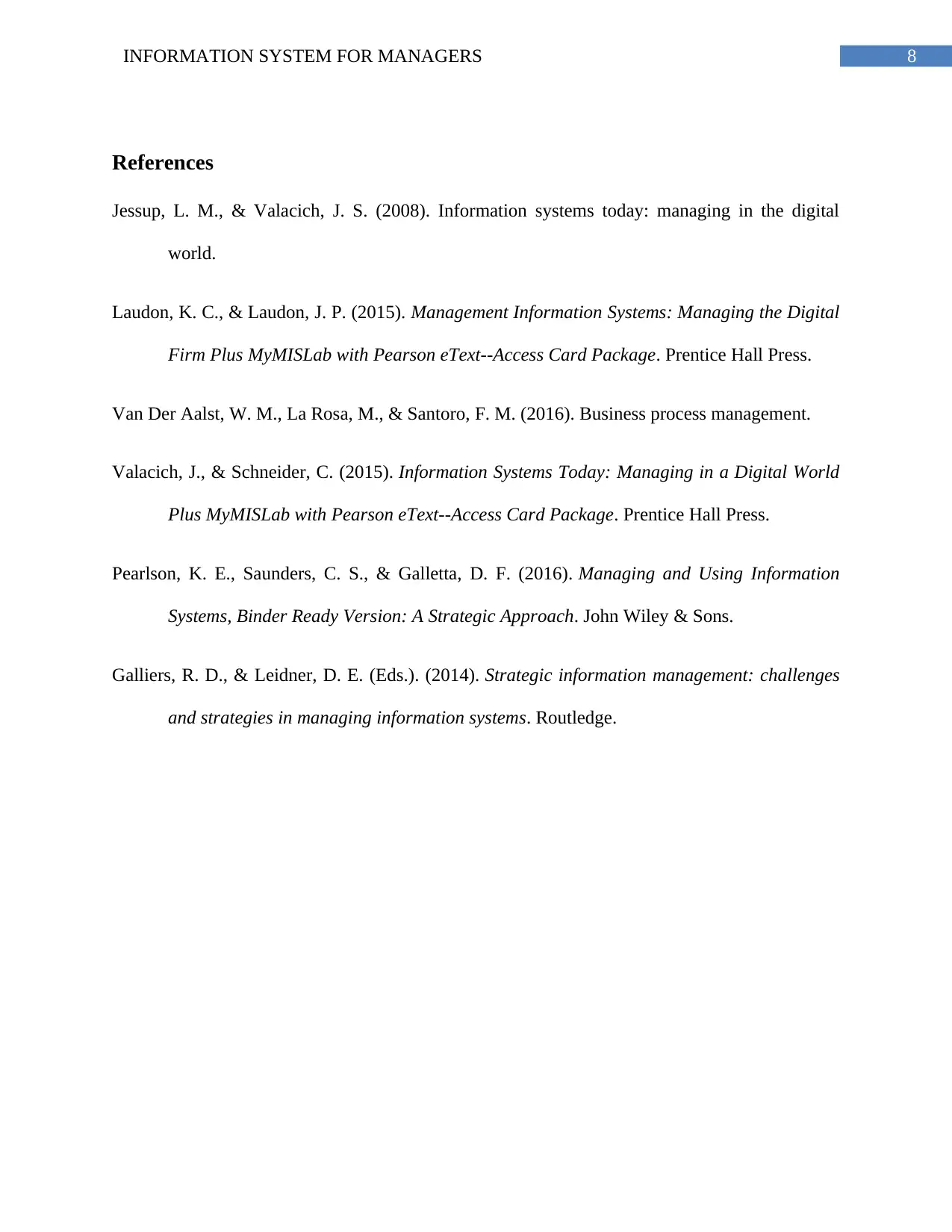
8INFORMATION SYSTEM FOR MANAGERS
References
Jessup, L. M., & Valacich, J. S. (2008). Information systems today: managing in the digital
world.
Laudon, K. C., & Laudon, J. P. (2015). Management Information Systems: Managing the Digital
Firm Plus MyMISLab with Pearson eText--Access Card Package. Prentice Hall Press.
Van Der Aalst, W. M., La Rosa, M., & Santoro, F. M. (2016). Business process management.
Valacich, J., & Schneider, C. (2015). Information Systems Today: Managing in a Digital World
Plus MyMISLab with Pearson eText--Access Card Package. Prentice Hall Press.
Pearlson, K. E., Saunders, C. S., & Galletta, D. F. (2016). Managing and Using Information
Systems, Binder Ready Version: A Strategic Approach. John Wiley & Sons.
Galliers, R. D., & Leidner, D. E. (Eds.). (2014). Strategic information management: challenges
and strategies in managing information systems. Routledge.
References
Jessup, L. M., & Valacich, J. S. (2008). Information systems today: managing in the digital
world.
Laudon, K. C., & Laudon, J. P. (2015). Management Information Systems: Managing the Digital
Firm Plus MyMISLab with Pearson eText--Access Card Package. Prentice Hall Press.
Van Der Aalst, W. M., La Rosa, M., & Santoro, F. M. (2016). Business process management.
Valacich, J., & Schneider, C. (2015). Information Systems Today: Managing in a Digital World
Plus MyMISLab with Pearson eText--Access Card Package. Prentice Hall Press.
Pearlson, K. E., Saunders, C. S., & Galletta, D. F. (2016). Managing and Using Information
Systems, Binder Ready Version: A Strategic Approach. John Wiley & Sons.
Galliers, R. D., & Leidner, D. E. (Eds.). (2014). Strategic information management: challenges
and strategies in managing information systems. Routledge.
⊘ This is a preview!⊘
Do you want full access?
Subscribe today to unlock all pages.

Trusted by 1+ million students worldwide
1 out of 9
Related Documents
Your All-in-One AI-Powered Toolkit for Academic Success.
+13062052269
info@desklib.com
Available 24*7 on WhatsApp / Email
![[object Object]](/_next/static/media/star-bottom.7253800d.svg)
Unlock your academic potential
Copyright © 2020–2025 A2Z Services. All Rights Reserved. Developed and managed by ZUCOL.




